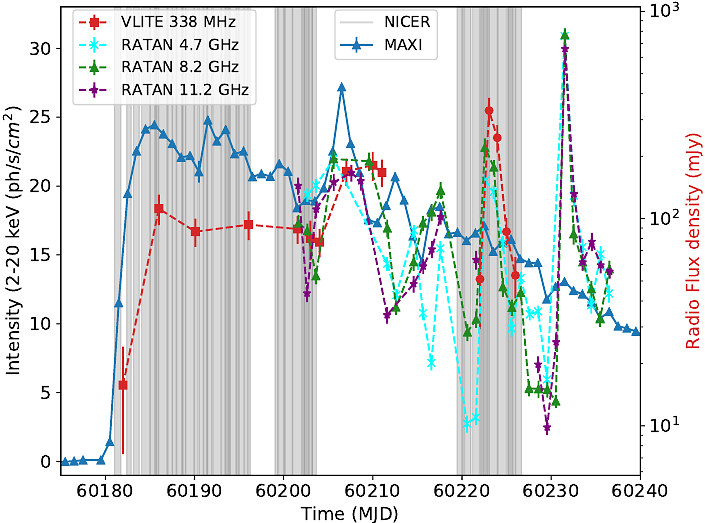Evolution of the Comptonizing medium of the black-hole candidate Swift J1727.8$-$1613 along the hard to hard-intermediate state transition using NICER

Evolution of the Comptonizing medium of the black-hole candidate Swift J1727.8$-$1613 along the hard to hard-intermediate state transition using NICER
Divya Rawat, Mariano Méndez, Federico García, Pierre Maggi
AbstractWe analyse the properties of the Comptonizing medium in the black-hole X-ray binary Swift J1727.8$-$1613 using the time-dependent Comptonization model vkompth, using NICER observations of type-C QPOs in the hard and hard-intermediate states. During the 2023 outburst of the source, we measure the rms and phase lags of the QPO across 45 observations as the QPO frequency, $\nu_{\rm QPO}$, evolves from $\sim 0.3$ Hz to $\sim 7$ Hz. By simultaneously fitting the time-averaged spectrum of the source and the rms and lag spectra of the QPO, we derive the evolution of the disk and corona parameters. At $\nu_{\rm QPO} = 0.34$ Hz, the QPO phase lags are hard, with 10 keV photons lagging 0.5 keV photons by $\sim 0.5$ rad. As $\nu_{\rm QPO}$ increases, the lags for the same energy bands decrease, reaching near zero at $\nu_{\rm QPO} \sim 1.2$ Hz, and then reverse to soft lags of $\sim -1.1$ rad at $\nu_{\rm QPO} \sim 7$ Hz. Initially, the inner radius of the accretion disk is truncated at $\sim 30-40 R_g$ (assuming a 10 solar-mass black hole) and, as the QPO frequency increases, the truncation radius decreases down to $\sim 10 R_g$. Initially, two coronas of sizes of $\sim 6.5 \times 10^3$ km and $\sim 2 \times 10^3$ km, extend over the disk and are illuminated by different regions of the disk. As the QPO frequency increases, both the coronas shrink to $\sim 2 \times 10^3$ km at $\nu_{\rm QPO} = 2.5$ Hz. Following a data gap, one corona expands again, peaking at a size of $\sim 2 \times 10^4$ km. We interpret the evolution of the coronal size in the context of accompanying radio observations, discussing its implications for the interplay between the corona and the jet.